#STOVL
Explore tagged Tumblr posts
Text


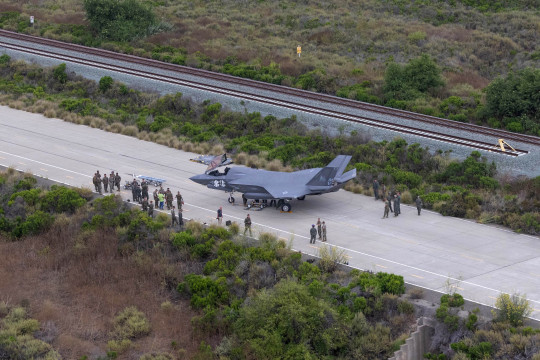





F-35B during the US Marines exercise Obsidian Iceberg on the stretch of Pacific Coast Highway that passes through Camp Pendleton
#Lockheed Martin F-35B Lightning II#Bell Boeing V-22 Osprey#Obsidian Iceberg#Camp Pendleton#aviation#STOVL
5 notes
·
View notes
Text

Photo of the Day: A U.S. Marine Corps F-35B Lightning II STOVL aircraft flies over Solomons Island while returning to Naval Air Station Patuxent River, Maryland following airborne gunfire testing
credit NAVAIR
@kadonkey via X
24 notes
·
View notes
Text
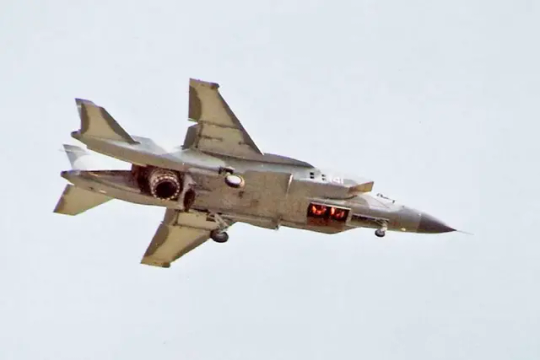
Yak-141 with all three of its engine visible. Intended as a replacement for the Yak-38, it was designed as a supersonic fleet defence fighter capable of STOVL/VTOL operating from Soviet carriers. Four prototypes were built before the project's cancellation.
38 notes
·
View notes
Text

F-35B The Air Force's mission in the Indo-Pacific has entered its fourth phase; two F-35Bs of the Armed Force, with a small contingent of about 40 people, are embarked on the aircraft carrier Cavour of the Navy, for joint training at a great distance from Italy. With this exercise, the Air Force and the Navy are advancing interoperability and the development of joint capabilities that constitute a further step forward in the integration of the F-35B fifth-generation omnirole aircraft, with STOVL (short take-off and vertical landing) characteristics, highlighting their capabilities and versatility.
AeronauticaMilitareNelMondo #ItalianAirForce #latuasquadrachevola
4 notes
·
View notes
Text


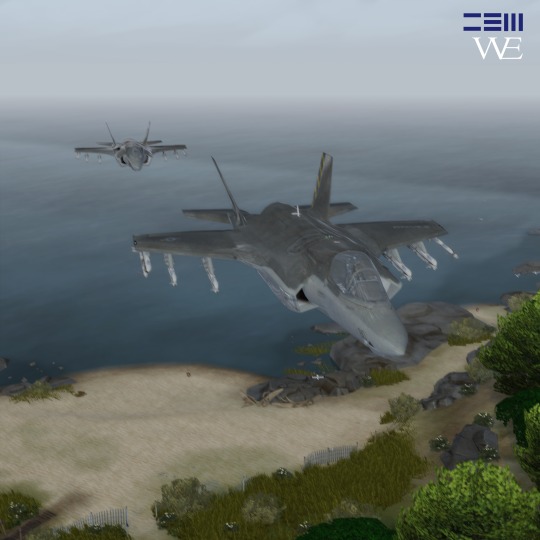
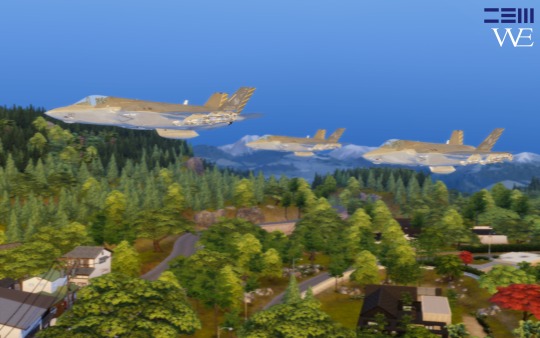


STOVL Fighters Collection DOWNLOAD
At the end of 1950s, the engineers had just an idea of delivering the aircraft even without a runway. Then in the beginning of 1960s, some tests conducted to test the capability of STOVL (Short Take-Off Vertical Landing) or in other word, a possibility of vertical movement of the fixed-wing aircraft, began with the "Flying bunk" in1959. Then the Hawker Siddeley Limited in Britain proposed a concept named "P1127 Kestrel" as a prototype of the VTOL fighter. Then this concept acepted and in 1969, the production of Harrier GR1 had begun. This aircraft was intended to be in use for Royal Air Force, but the Royal Navy also got their own version of FRS1 years later. These Harriers sought it's first battle experience in Falklands War in 1982 when these Harriers brought down some of the Argentine's air capability without any losses. The last of the Harrier production was in GR9 variant which subsequently substituted by the latest F-35B by the Royal Air Force.
McDonnell-Douglas AV-8B Harrier II
The USMC was also seeking the aircraft that suits for the amphibious mission. After the success of the Harrier FRS1 and GR3 variants in the Falklands War, in 1985 the USMC proposed an inquiry to acquire some of these aircrafts, with also stated that these aircrafts should be manufactured in the United States. Then BAe Industries licensed the Harrier to the McDonnell-Douglas company . Also this aircraft met the service within the Royal Spanish Navy in 1987. Several missions has been done by AV-8Bs including Gulf War, Operation Enduring Freedom, Operation Iraqi Freedom and Libyan Crisis.
Lockheed Martin F-35B
The STOVL variant of F-35 Thunderbolt which it's STOVL technology derived from Yak-141 VTOL system, which sold to the Lockheed Martin in 1992, which emphasizes the vector exhaust and a fan in the middle of the aircraft. Also the most wanted aircraft in action of this century. The F-35B is the short take-off and vertical landing (STOVL) variant of the aircraft. Similar in size to the A variant, the B sacrifices about a third of the A variant's fuel volume to accommodate the SDLF. This variant is limited to 7 g. Unlike other variants, the F-35B has no landing hook. The "STOVL/HOOK" control instead engages conversion between normal and vertical flight.The F-35B is capable of Mach 1.6 (1,976 km/h) and can perform vertical and/or short take-off and landing (V/STOL)
#the sims 4#the sims#the sims 4 custom content#ts4 cc#ts4military#the sims 4 military#ts4#the sims 4 cc#ts4cc#deus ex machina#the sims 4 decades challenge#ts4 decades challenge#sims 4 decades#early 2000s#late 2000s#2000s style#fighter jet#f 35 lightning ii#british#american
29 notes
·
View notes
Text
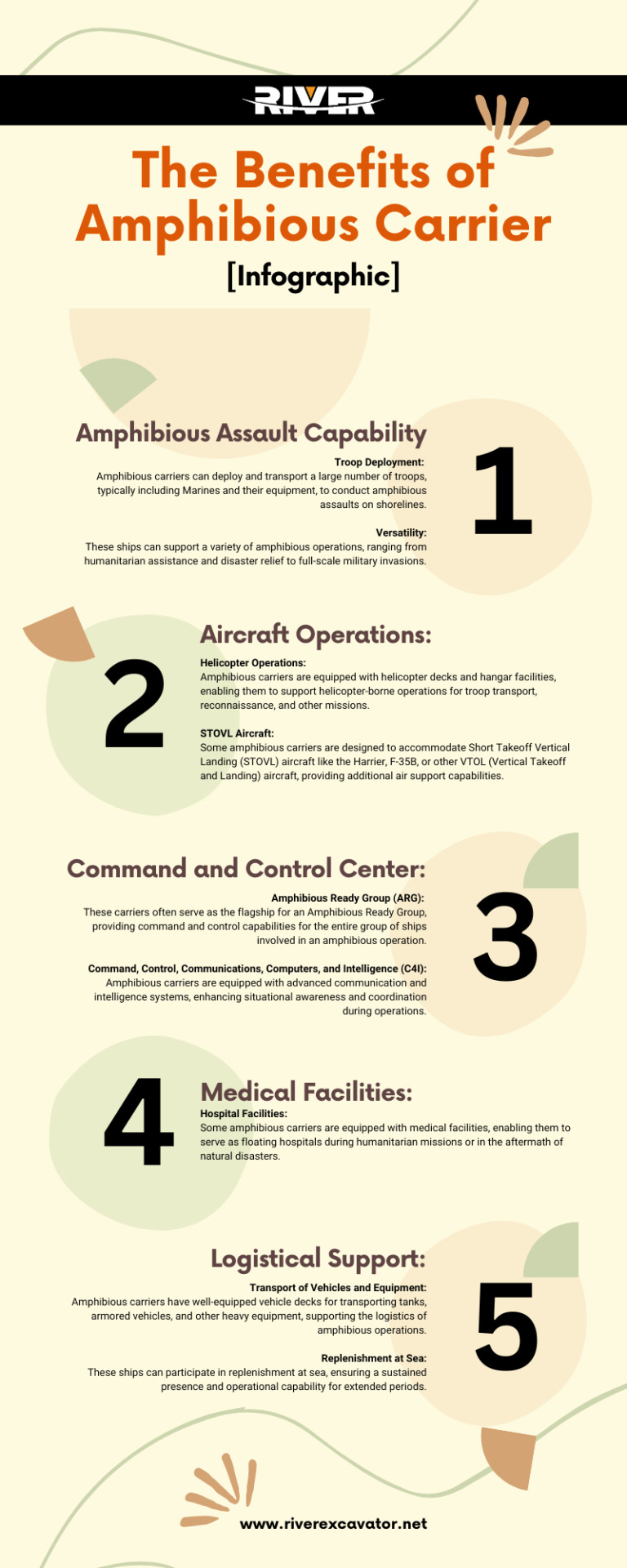
The Benefits of Amphibious Carrier [Infographic]
Amphibious carriers, also known as amphibious assault ships or helicopter carriers, are versatile naval vessels designed to support amphibious operations.
These ships have several benefits that make them valuable assets to a navy:
1. Amphibious Assault Capability:
Troop Deployment: Amphibious carriers can deploy and transport a large number of troops, typically including Marines and their equipment, to conduct amphibious assaults on shorelines.
Versatility: These ships can support a variety of amphibious operations, ranging from humanitarian assistance and disaster relief to full-scale military invasions.
2. Aircraft Operations:
Helicopter Operations: Amphibious carriers are equipped with helicopter decks and hangar facilities, enabling them to support helicopter-borne operations for troop transport, reconnaissance, and other missions.
STOVL Aircraft: Some amphibious carriers are designed to accommodate Short Takeoff Vertical Landing (STOVL) aircraft like the Harrier, F-35B, or other VTOL (Vertical Takeoff and Landing) aircraft, providing additional air support capabilities.
3. Command and Control Center:
Amphibious Ready Group (ARG): These carriers often serve as the flagship for an Amphibious Ready Group, providing command and control capabilities for the entire group of ships involved in an amphibious operation.
Command, Control, Communications, Computers, and Intelligence (C4I): Amphibious carriers are equipped with advanced communication and intelligence systems, enhancing situational awareness and coordination during operations.
4. Medical Facilities:
Hospital Facilities: Some amphibious carriers are equipped with medical facilities, enabling them to serve as floating hospitals during humanitarian missions or in the aftermath of natural disasters.
5. Logistical Support:
Transport of Vehicles and Equipment: Amphibious carriers have well-equipped vehicle decks for transporting tanks, armored vehicles, and other heavy equipment, supporting the logistics of amphibious operations.
Replenishment at Sea: These ships can participate in replenishment at sea, ensuring a sustained presence and operational capability for extended periods.
6. Flexible Response:
Rapid Deployment: Amphibious carriers provide the ability to rapidly respond to crises or conflicts, projecting power across coastlines and supporting a range of military and humanitarian missions.
7. Deterrence:
Strategic Presence: The presence of amphibious carriers in certain regions can serve as a deterrent, influencing the strategic calculus of potential adversaries.
8. Humanitarian Assistance and Disaster Relief (HADR):
Versatile Deployment: Amphibious carriers are capable of supporting HADR missions, delivering aid and relief supplies quickly to disaster-stricken areas.
While amphibious carriers offer numerous advantages, it's important to note that their effectiveness depends on factors such as technology, maintenance, and the overall strategy and doctrine of the navy utilizing them.
Related:
What is Beyond Borders: Amphibious Carriers and the Future of Naval Warfare?
3 notes
·
View notes
Text
Italian Air Force Stands Up New F-35B Squadron
The 101st Gruppo (Squadron), reactivated after a period in “quadro” (dormant) status, will operate the STOVL variant of the Lightning II aircraft from Amendola Air Base. On Jul. 1, 2025, during a ceremony attended by several former members of the unit, the Aeronautica Militare (Italian Air Force) reactivated the 101° Gruppo to operate the service’s F-35B STOVL (Short Take-Off and Vertical…
0 notes
Text
F-55
While visiting Qatar, President Trump said he wants the U.S. to build a twin-engine version of the F-35, which he’s calling the F-55. He’s never liked that the F-35 only has one engine—he thinks two would be safer and offer better performance. But honestly, nobody knows how serious this is or if it’s just Trump spitballing.
So what would this “F-55” actually mean?
Twin Engines: Trump says two engines mean more safety and more power—think faster speeds, higher altitude, and bigger payloads. But it would mean a total redesign: heavier jet, more expensive, and way more to maintain.
Possible Engines: If this did happen, they’d probably use engines from the Next Generation Adaptive Propulsion (NGAP) program—the same stuff that’s in the works for the Air Force’s new F-47 stealth fighter.
Navy’s Angle: The Navy might actually like a twin-engine F-35, especially for carrier ops (F-35C). More thrust and redundancy are always good at sea. But to be honest, there haven’t been any big safety issues with the current single-engine F-35Cs so far.
No F-35B Version: Forget about putting two engines in the Marine Corps’ F-35B (STOVL version)—it just won’t work with the vertical landing design.
Export Potential: Trump might be pitching this to Gulf allies like Saudi Arabia and the UAE, especially while in Qatar. Those countries have shown interest in advanced U.S. fighters before.
F-35 Upgrades: Trump also mentioned a “simple upgrade” and a “super upgrade” for the F-35. Lockheed Martin recently talked about a souped-up F-35—think “80% of the F-47’s capability at half the price.” That’s probably what he means by “super upgrade.”
F-22 Super: Trump called the F-22 “the most beautiful fighter in the world” and wants a “very modern” version—an “F-22 Super.” That lines up with what the Air Force is already doing: adding new sensors, a defensive infrared system, and stealthy drop tanks to keep the Raptor relevant until the 2040s.
Is This Real? Here’s the thing: Trump has a history of making up jet designations on the fly (remember the “F-52”?). So, it’s possible the F-55 is just an idea, not an actual program. No word yet from the Pentagon or the services about any real work on this.
Bottom line from the cockpit: A twin-engine F-35 would be a beast—faster, safer, maybe more capable for the Navy and some export partners. But it would take a ton of work and money to make it happen, and so far, there’s no official plan to build it. For now, both the F-35 and F-22 are getting serious upgrades that’ll keep them dangerous for years. The F-55 idea? For now, it’s just talk.
0 notes
Text
@greginsd
The F-35B is part of the Lockheed Martin F-35 Lightning II family, and its official designation is simply F-35B Lightning II. The "B" indicates its variant, which is the short take-off and vertical-landing (STOVL) model, designed primarily for the U.S. Marine Corps .
♬ original sound - greginsd
0 notes
Video
youtube
L'avion de chasse F-35 : un joyau de la technologie militaire
L'avion de chasse F-35 Lightning II, conçu par Lockheed Martin, est l'une des machines les plus sophistiquées et polyvalentes jamais créées. Intégrant les dernières avancées technologiques en matière de furtivité, d'avionique et de connectivité, cet avion est souvent perçu comme l'avenir de l'aviation militaire.
Caractéristiques principales
1. **Furtivité de pointe :** Le F-35 est conçu pour être difficilement détectable par les radars ennemis grâce à ses matériaux composites et son design spécifique. Cela lui confère un avantage stratégique sur les champs de bataille modernes.
2. **Polyvalence :** Cet appareil est décliné en trois variantes principales : - **F-35A :** Variante classique pour les forces aériennes. - **F-35B :** Capable d'effectuer des décollages courts et des atterrissages verticaux (STOVL). - **F-35C :** Conçu pour opérer à partir des porte-avions avec un train d'atterrissage renforcé et des ailes pliables.
3. **Technologie embarquée :** L'avion dispose de capteurs avancés et d'un système de fusion des données, permettant aux pilotes d'avoir une vue d'ensemble en temps réel du champ de bataille. Son casque sophistiqué projette les informations critiques directement sur la visière, éliminant le besoin d'un affichage traditionnel.
4. **Arsenal redoutable :** Le F-35 peut transporter une grande variété d'armes, des missiles air-air aux bombes guidées. Grâce à sa conception furtive, une partie de son armement peut être logée dans ses soutes internes.
Défis et controverses
Le F-35 n'est pas exempt de critiques. Son développement a été marqué par des dépassements de coûts et des retards importants. De plus, certains experts s'interrogent sur la rentabilité de cet avion comparé à d'autres modèles. Cependant, malgré ces défis, il reste un symbole de la supériorité technologique et stratégique.
Impact mondial
Adopté par plusieurs pays, dont les États-Unis, le Royaume-Uni, Israël et le Japon, le F-35 joue un rôle clé dans la modernisation des forces aériennes à travers le monde. Il est vu non seulement comme une arme, mais aussi comme un outil de dissuasion et de collaboration entre nations alliées.
En somme, le F-35 Lightning II incarne le summum de l'innovation en aviation militaire, avec ses capacités impressionnantes et ses technologies futuristes. Cependant, son histoire rappelle également les défis et les compromis liés au développement de systèmes de défense ultra-avancés.
0 notes
Text

20 August 1978. First flight of the British Aerospace Sea Harrier FRS.Mk 1 (XZ450) at Dunsfold aerodrome, British naval VTOL/STOVL jet fighter, reconnaissance and attack aircraft, development of the Hawker Siddeley Harrier.
@ron_eisele via X
29 notes
·
View notes
Text
A Força de Autodefesa Marí... https://tradeemais.com/japao-realiza-testes-do-f-35b-a-bordo-do-js-kaga-tudo-sobre-o-avancado-caca-naval?feed_id=13174&_unique_id=672f4111b37f2
0 notes
Text
Harrier-hävittäjät lipuivat Länsisatamaan - Espanjan merivoimat Armada Española harjoittelee Suomessa | lentoposti.fi
0 notes
Text
Aircraft Carriers: Powerhouses of Modern Navies - A Deep Dive into Nimitz-Class, Queen Elizabeth-Class, and Global Carrier Fleets
Introduction to Aircraft Carriers
Aircraft carriers are monumental warships that serve as mobile airbases, enabling nations to project power far beyond their shores. They provide a platform for launching and recovering aircraft, which can perform a variety of roles, including air superiority, ground attack, anti-submarine warfare, and reconnaissance. These capabilities make aircraft carriers critical assets in modern naval strategy, allowing countries to exert influence over vast maritime regions, respond quickly to crises, and support global military operations.

Nimitz-Class Aircraft Carriers
The Nimitz-class carriers are a class of ten nuclear-powered aircraft carriers in service with the United States Navy. Named after Fleet Admiral Chester W. Nimitz, a key figure in the Pacific theater during World War II, these carriers have been the backbone of the U.S. Navy's carrier fleet since their introduction in the 1970s.
Design and Specifications: Nimitz-class carriers are among the largest warships in the world, each displacing around 100,000 tons. They measure approximately 1,092 feet in length and have a beam of 252 feet. Powered by two nuclear reactors, these carriers have a virtually unlimited range and can operate for over 20 years without refueling, providing sustained presence and flexibility.
Capabilities: The Nimitz-class carriers can accommodate about 90 aircraft, including F/A-18 Hornets, EA-18G Growlers, E-2C Hawkeyes, and MH-60R/S helicopters. The flight deck is equipped with four steam catapults, enabling rapid launch and recovery of aircraft. Advanced radar systems, electronic warfare capabilities, and missile defenses protect the carrier from various threats, ensuring it can operate effectively in contested environments.
Role and Deployment: Nimitz-class carriers have been deployed globally, participating in combat operations, humanitarian missions, and training exercises. They play a crucial role in projecting U.S. power, providing a credible deterrent, and supporting allies. Notable deployments include operations in the Persian Gulf, where they have supported combat missions in Iraq and Afghanistan, and disaster relief efforts in Southeast Asia.
Queen Elizabeth-Class Aircraft Carriers
The Queen Elizabeth-class carriers mark the Royal Navy's return to operating large aircraft carriers. This class comprises two ships: HMS Queen Elizabeth and HMS Prince of Wales. These carriers are the largest and most advanced warships ever built for the Royal Navy.
Design and Specifications: Each carrier displaces around 65,000 tons and measures 920 feet in length. They are conventionally powered, utilizing integrated electric propulsion systems. The design features twin islands, which improve command and control, and a ski-jump ramp for short take-off and vertical landing (STOVL) operations. The flight deck is capable of accommodating up to 40 aircraft.
Capabilities: The Queen Elizabeth-class carriers are designed primarily to operate the F-35B Lightning II, a fifth-generation multirole stealth fighter capable of STOVL operations. They can also deploy various helicopters, including the Merlin for anti-submarine warfare and airborne early warning, as well as Chinooks for troop transport. These carriers are equipped with advanced radar and self-defense systems, ensuring they can operate in high-threat environments.
Role and Deployment: These carriers enhance the UK's ability to project power globally. HMS Queen Elizabeth has already completed her maiden operational deployment, integrating with NATO allies and participating in multinational exercises in the Mediterranean, Indian Ocean, and the Pacific. The Queen Elizabeth-class carriers are expected to be central to the UK's defense strategy, providing rapid response capabilities and supporting international security efforts.
Aircraft Carriers by Country
Aircraft carriers are a potent symbol of naval power, and several nations operate or are developing carriers to bolster their strategic capabilities.
United States: The U.S. Navy operates 11 aircraft carriers, including the Nimitz-class and the new Ford-class, which will eventually replace the older Nimitz-class ships. These carriers form the core of the U.S. Navy's blue-water capabilities, ensuring global reach and influence. The Ford-class carriers introduce advanced technologies, including electromagnetic catapults and improved nuclear reactors, enhancing operational efficiency and combat capability.
United Kingdom: The Royal Navy operates two Queen Elizabeth-class carriers, which restore its ability to conduct carrier strike operations. These carriers are pivotal to the UK's defense strategy, enabling rapid response to crises and supporting global security efforts. Their integration with F-35B aircraft and advanced support systems enhances their operational versatility and effectiveness.
France: The French Navy operates the Charles de Gaulle, a nuclear-powered aircraft carrier. Commissioned in 2001, it supports a range of operations, from air superiority to anti-submarine warfare. The Charles de Gaulle has been deployed in various missions, including combat operations in the Middle East and humanitarian relief efforts. France plans to develop a new-generation carrier to replace it by the late 2030s, ensuring continued carrier capability.
China: China has been rapidly expanding its carrier capabilities, with two carriers currently in service: Liaoning (a refitted Soviet-era carrier) and Shandong (an indigenous design). A third, more advanced carrier, the Type 003, is under construction. These carriers signify China's growing naval ambitions and its desire to project power in the Asia-Pacific region. They support China's strategy of securing its maritime interests and extending its influence.
India: The Indian Navy operates INS Vikramaditya, a modified Kiev-class carrier, and is building its first indigenous carrier, INS Vikrant. These carriers are crucial for India's strategic presence in the Indian Ocean and beyond. They enhance India's ability to project power, support regional stability, and respond to maritime threats.
Russia: Russia's carrier capability is currently limited to the Admiral Kuznetsov, a vessel that has faced numerous technical challenges and is undergoing a lengthy refit. While Russia has plans to develop new carriers, financial and technical hurdles have delayed progress. Despite these challenges, Russia continues to prioritize carrier development as part of its broader naval modernization efforts.
Other Countries: Several other nations, including Italy, Spain, and Japan, operate smaller carriers or amphibious assault ships capable of launching fixed-wing aircraft. These platforms enhance their regional capabilities and support international operations. For instance, Japan's Izumo-class ships are being modified to operate F-35B aircraft, reflecting a strategic shift towards increased carrier capability.
Conclusion

Aircraft carriers by country remain a central component of modern naval strategy, offering unmatched versatility and power projection. The Nimitz-class and Queen Elizabeth-class carriers exemplify the pinnacle of carrier design and capability, each serving their respective nations' strategic needs. As more countries seek to develop or expand their carrier capabilities, the global naval landscape continues to evolve, underscoring the enduring importance of these formidable vessels. Whether through deterrence, humanitarian aid, or combat operations, aircraft carriers will continue to shape the future of naval warfare.
0 notes
Video
The AV-8B Harrier II STOVL Action was a crucial weapon in the Gulf War.
0 notes
